Assignment on Evidence Based Practice Project
VerifiedAdded on 2022/08/24
|17
|3425
|14
AI Summary
Contribute Materials
Your contribution can guide someone’s learning journey. Share your
documents today.
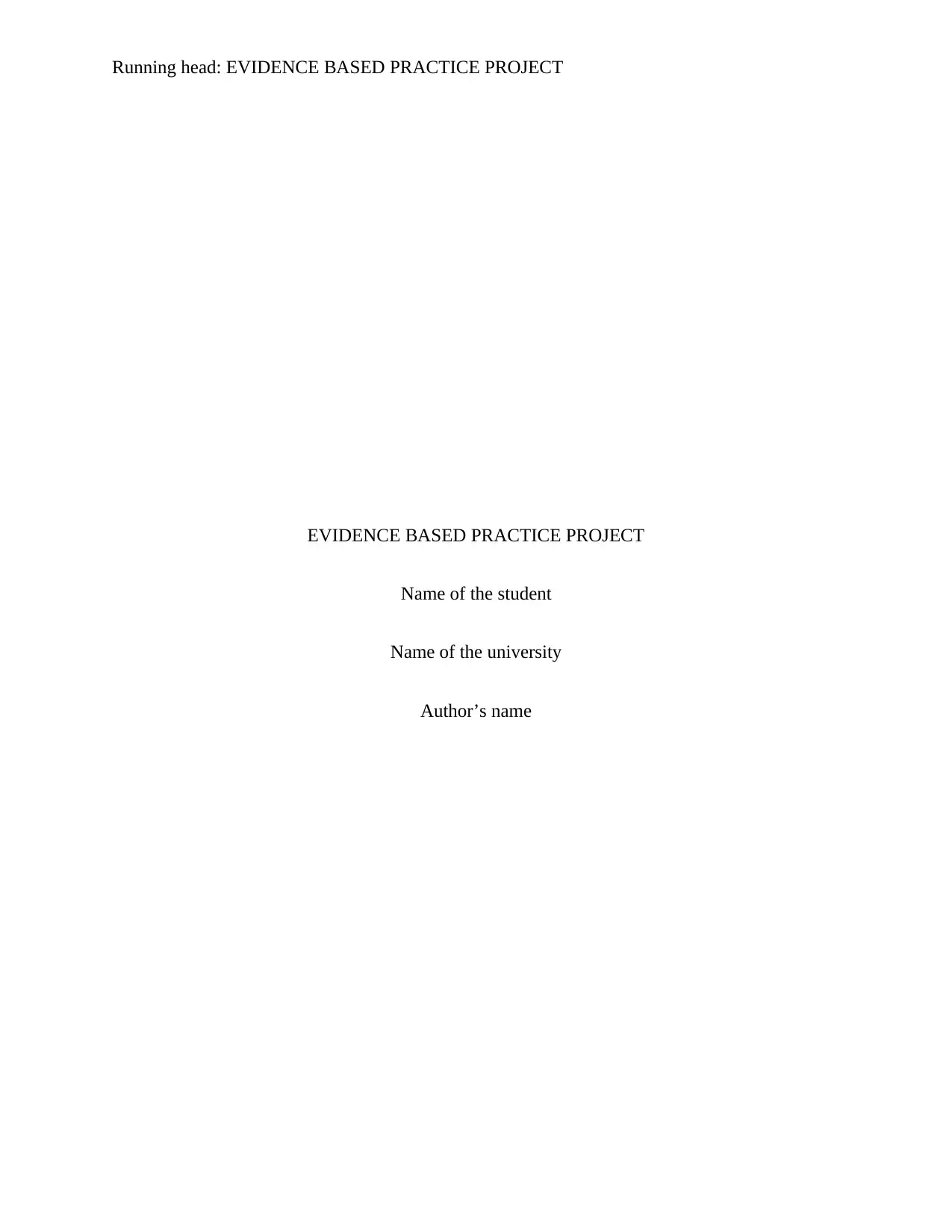
Running head: EVIDENCE BASED PRACTICE PROJECT
EVIDENCE BASED PRACTICE PROJECT
Name of the student
Name of the university
Author’s name
EVIDENCE BASED PRACTICE PROJECT
Name of the student
Name of the university
Author’s name
Secure Best Marks with AI Grader
Need help grading? Try our AI Grader for instant feedback on your assignments.
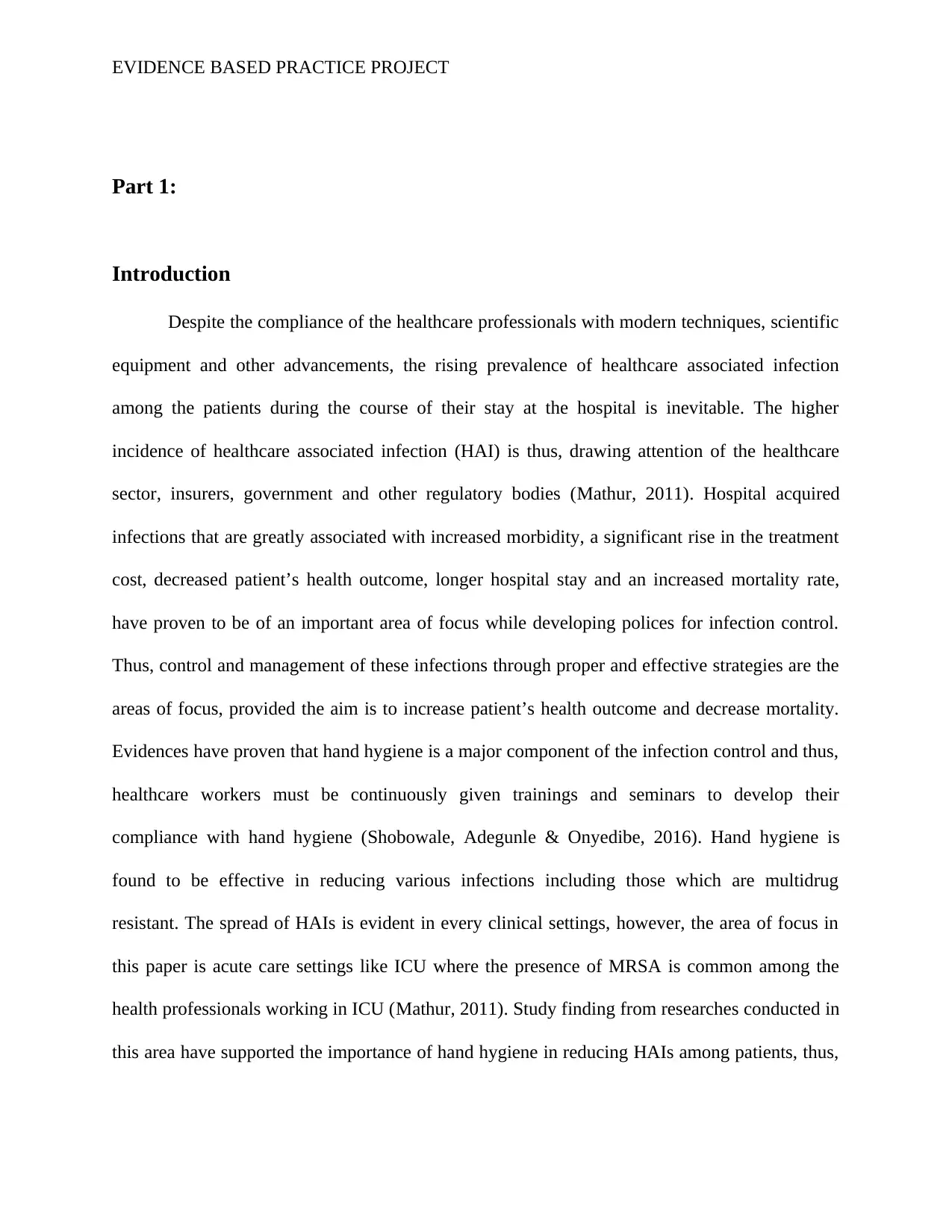
EVIDENCE BASED PRACTICE PROJECT
Part 1:
Introduction
Despite the compliance of the healthcare professionals with modern techniques, scientific
equipment and other advancements, the rising prevalence of healthcare associated infection
among the patients during the course of their stay at the hospital is inevitable. The higher
incidence of healthcare associated infection (HAI) is thus, drawing attention of the healthcare
sector, insurers, government and other regulatory bodies (Mathur, 2011). Hospital acquired
infections that are greatly associated with increased morbidity, a significant rise in the treatment
cost, decreased patient’s health outcome, longer hospital stay and an increased mortality rate,
have proven to be of an important area of focus while developing polices for infection control.
Thus, control and management of these infections through proper and effective strategies are the
areas of focus, provided the aim is to increase patient’s health outcome and decrease mortality.
Evidences have proven that hand hygiene is a major component of the infection control and thus,
healthcare workers must be continuously given trainings and seminars to develop their
compliance with hand hygiene (Shobowale, Adegunle & Onyedibe, 2016). Hand hygiene is
found to be effective in reducing various infections including those which are multidrug
resistant. The spread of HAIs is evident in every clinical settings, however, the area of focus in
this paper is acute care settings like ICU where the presence of MRSA is common among the
health professionals working in ICU (Mathur, 2011). Study finding from researches conducted in
this area have supported the importance of hand hygiene in reducing HAIs among patients, thus,
Part 1:
Introduction
Despite the compliance of the healthcare professionals with modern techniques, scientific
equipment and other advancements, the rising prevalence of healthcare associated infection
among the patients during the course of their stay at the hospital is inevitable. The higher
incidence of healthcare associated infection (HAI) is thus, drawing attention of the healthcare
sector, insurers, government and other regulatory bodies (Mathur, 2011). Hospital acquired
infections that are greatly associated with increased morbidity, a significant rise in the treatment
cost, decreased patient’s health outcome, longer hospital stay and an increased mortality rate,
have proven to be of an important area of focus while developing polices for infection control.
Thus, control and management of these infections through proper and effective strategies are the
areas of focus, provided the aim is to increase patient’s health outcome and decrease mortality.
Evidences have proven that hand hygiene is a major component of the infection control and thus,
healthcare workers must be continuously given trainings and seminars to develop their
compliance with hand hygiene (Shobowale, Adegunle & Onyedibe, 2016). Hand hygiene is
found to be effective in reducing various infections including those which are multidrug
resistant. The spread of HAIs is evident in every clinical settings, however, the area of focus in
this paper is acute care settings like ICU where the presence of MRSA is common among the
health professionals working in ICU (Mathur, 2011). Study finding from researches conducted in
this area have supported the importance of hand hygiene in reducing HAIs among patients, thus,
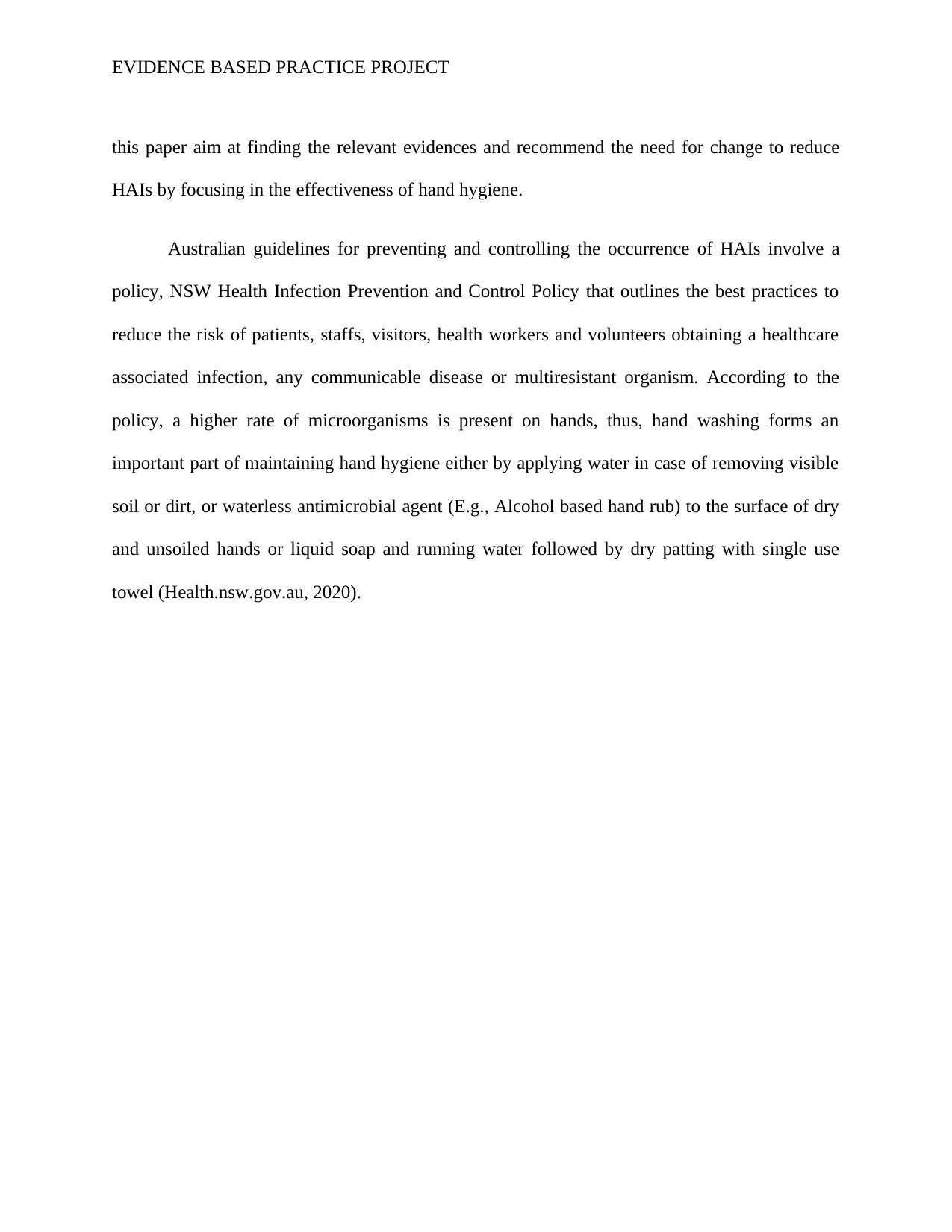
EVIDENCE BASED PRACTICE PROJECT
this paper aim at finding the relevant evidences and recommend the need for change to reduce
HAIs by focusing in the effectiveness of hand hygiene.
Australian guidelines for preventing and controlling the occurrence of HAIs involve a
policy, NSW Health Infection Prevention and Control Policy that outlines the best practices to
reduce the risk of patients, staffs, visitors, health workers and volunteers obtaining a healthcare
associated infection, any communicable disease or multiresistant organism. According to the
policy, a higher rate of microorganisms is present on hands, thus, hand washing forms an
important part of maintaining hand hygiene either by applying water in case of removing visible
soil or dirt, or waterless antimicrobial agent (E.g., Alcohol based hand rub) to the surface of dry
and unsoiled hands or liquid soap and running water followed by dry patting with single use
towel (Health.nsw.gov.au, 2020).
this paper aim at finding the relevant evidences and recommend the need for change to reduce
HAIs by focusing in the effectiveness of hand hygiene.
Australian guidelines for preventing and controlling the occurrence of HAIs involve a
policy, NSW Health Infection Prevention and Control Policy that outlines the best practices to
reduce the risk of patients, staffs, visitors, health workers and volunteers obtaining a healthcare
associated infection, any communicable disease or multiresistant organism. According to the
policy, a higher rate of microorganisms is present on hands, thus, hand washing forms an
important part of maintaining hand hygiene either by applying water in case of removing visible
soil or dirt, or waterless antimicrobial agent (E.g., Alcohol based hand rub) to the surface of dry
and unsoiled hands or liquid soap and running water followed by dry patting with single use
towel (Health.nsw.gov.au, 2020).
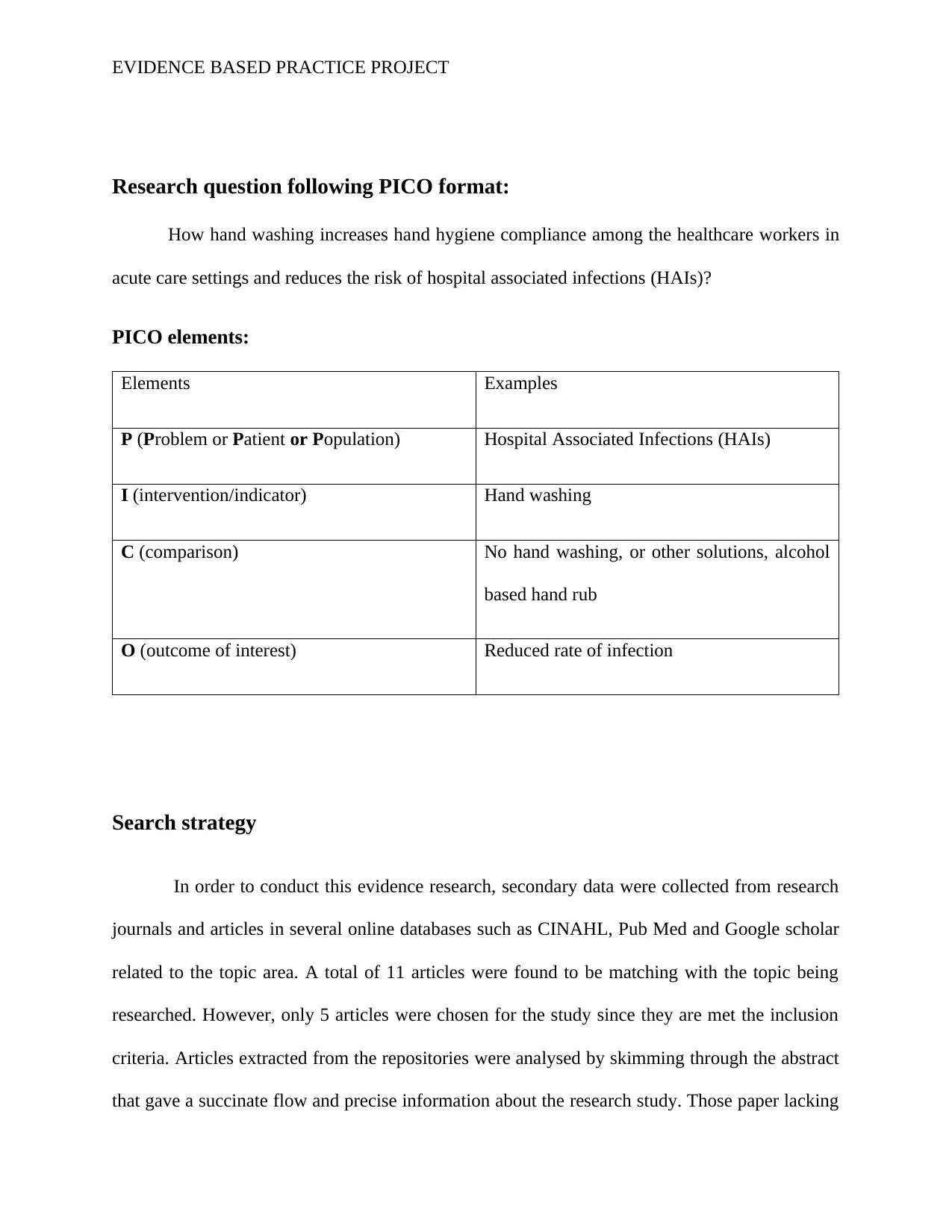
EVIDENCE BASED PRACTICE PROJECT
Research question following PICO format:
How hand washing increases hand hygiene compliance among the healthcare workers in
acute care settings and reduces the risk of hospital associated infections (HAIs)?
PICO elements:
Elements Examples
P (Problem or Patient or Population) Hospital Associated Infections (HAIs)
I (intervention/indicator) Hand washing
C (comparison) No hand washing, or other solutions, alcohol
based hand rub
O (outcome of interest) Reduced rate of infection
Search strategy
In order to conduct this evidence research, secondary data were collected from research
journals and articles in several online databases such as CINAHL, Pub Med and Google scholar
related to the topic area. A total of 11 articles were found to be matching with the topic being
researched. However, only 5 articles were chosen for the study since they are met the inclusion
criteria. Articles extracted from the repositories were analysed by skimming through the abstract
that gave a succinate flow and precise information about the research study. Those paper lacking
Research question following PICO format:
How hand washing increases hand hygiene compliance among the healthcare workers in
acute care settings and reduces the risk of hospital associated infections (HAIs)?
PICO elements:
Elements Examples
P (Problem or Patient or Population) Hospital Associated Infections (HAIs)
I (intervention/indicator) Hand washing
C (comparison) No hand washing, or other solutions, alcohol
based hand rub
O (outcome of interest) Reduced rate of infection
Search strategy
In order to conduct this evidence research, secondary data were collected from research
journals and articles in several online databases such as CINAHL, Pub Med and Google scholar
related to the topic area. A total of 11 articles were found to be matching with the topic being
researched. However, only 5 articles were chosen for the study since they are met the inclusion
criteria. Articles extracted from the repositories were analysed by skimming through the abstract
that gave a succinate flow and precise information about the research study. Those paper lacking
Secure Best Marks with AI Grader
Need help grading? Try our AI Grader for instant feedback on your assignments.
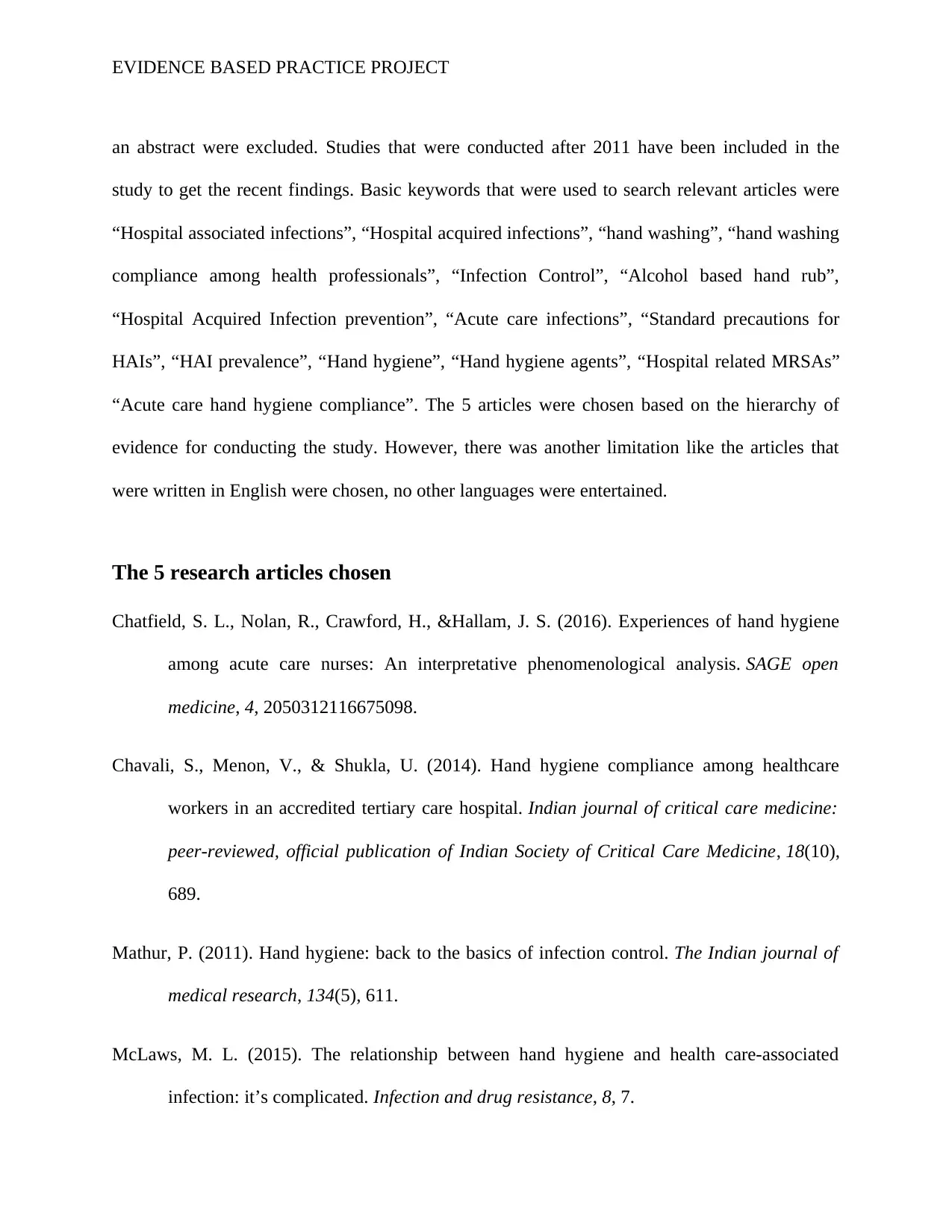
EVIDENCE BASED PRACTICE PROJECT
an abstract were excluded. Studies that were conducted after 2011 have been included in the
study to get the recent findings. Basic keywords that were used to search relevant articles were
“Hospital associated infections”, “Hospital acquired infections”, “hand washing”, “hand washing
compliance among health professionals”, “Infection Control”, “Alcohol based hand rub”,
“Hospital Acquired Infection prevention”, “Acute care infections”, “Standard precautions for
HAIs”, “HAI prevalence”, “Hand hygiene”, “Hand hygiene agents”, “Hospital related MRSAs”
“Acute care hand hygiene compliance”. The 5 articles were chosen based on the hierarchy of
evidence for conducting the study. However, there was another limitation like the articles that
were written in English were chosen, no other languages were entertained.
The 5 research articles chosen
Chatfield, S. L., Nolan, R., Crawford, H., &Hallam, J. S. (2016). Experiences of hand hygiene
among acute care nurses: An interpretative phenomenological analysis. SAGE open
medicine, 4, 2050312116675098.
Chavali, S., Menon, V., & Shukla, U. (2014). Hand hygiene compliance among healthcare
workers in an accredited tertiary care hospital. Indian journal of critical care medicine:
peer-reviewed, official publication of Indian Society of Critical Care Medicine, 18(10),
689.
Mathur, P. (2011). Hand hygiene: back to the basics of infection control. The Indian journal of
medical research, 134(5), 611.
McLaws, M. L. (2015). The relationship between hand hygiene and health care-associated
infection: it’s complicated. Infection and drug resistance, 8, 7.
an abstract were excluded. Studies that were conducted after 2011 have been included in the
study to get the recent findings. Basic keywords that were used to search relevant articles were
“Hospital associated infections”, “Hospital acquired infections”, “hand washing”, “hand washing
compliance among health professionals”, “Infection Control”, “Alcohol based hand rub”,
“Hospital Acquired Infection prevention”, “Acute care infections”, “Standard precautions for
HAIs”, “HAI prevalence”, “Hand hygiene”, “Hand hygiene agents”, “Hospital related MRSAs”
“Acute care hand hygiene compliance”. The 5 articles were chosen based on the hierarchy of
evidence for conducting the study. However, there was another limitation like the articles that
were written in English were chosen, no other languages were entertained.
The 5 research articles chosen
Chatfield, S. L., Nolan, R., Crawford, H., &Hallam, J. S. (2016). Experiences of hand hygiene
among acute care nurses: An interpretative phenomenological analysis. SAGE open
medicine, 4, 2050312116675098.
Chavali, S., Menon, V., & Shukla, U. (2014). Hand hygiene compliance among healthcare
workers in an accredited tertiary care hospital. Indian journal of critical care medicine:
peer-reviewed, official publication of Indian Society of Critical Care Medicine, 18(10),
689.
Mathur, P. (2011). Hand hygiene: back to the basics of infection control. The Indian journal of
medical research, 134(5), 611.
McLaws, M. L. (2015). The relationship between hand hygiene and health care-associated
infection: it’s complicated. Infection and drug resistance, 8, 7.
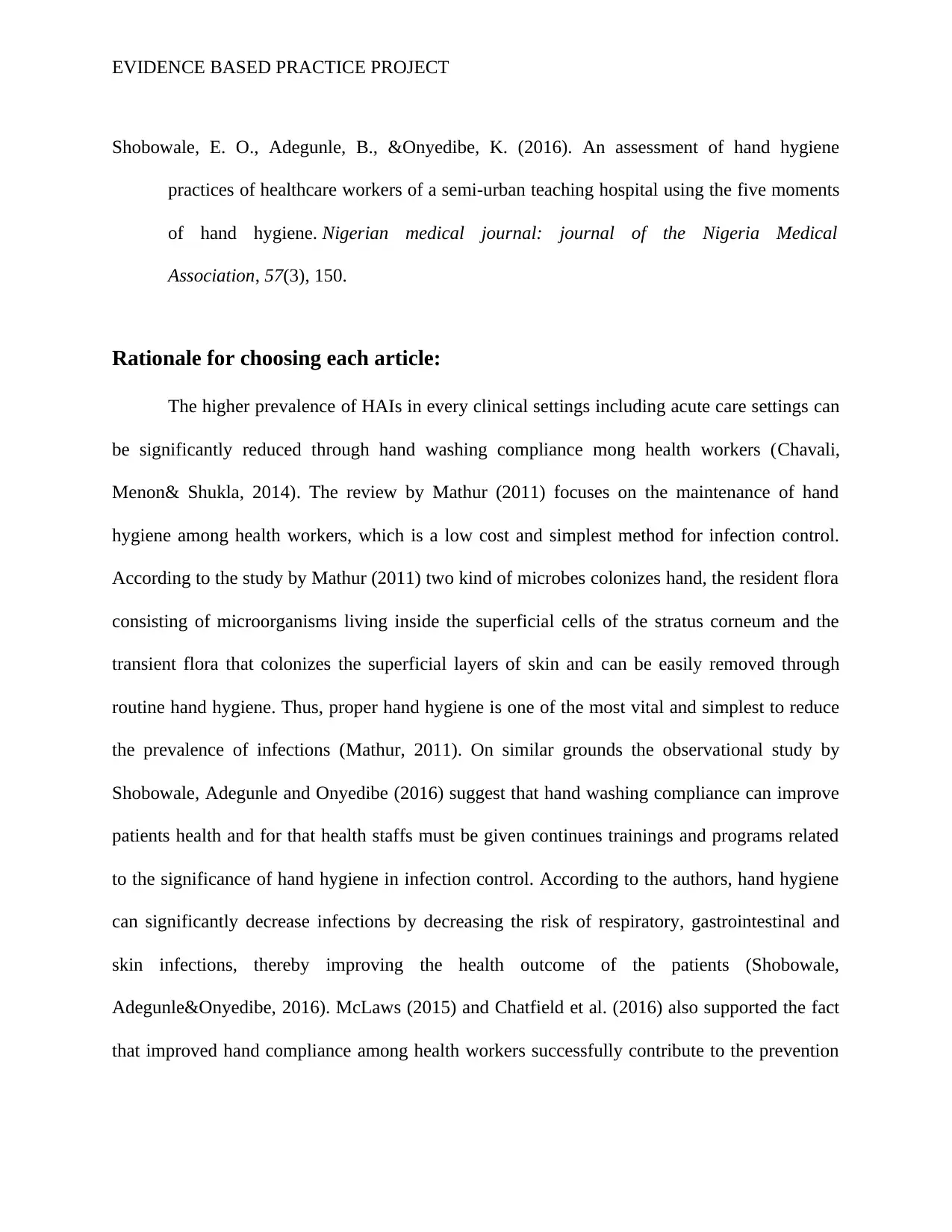
EVIDENCE BASED PRACTICE PROJECT
Shobowale, E. O., Adegunle, B., &Onyedibe, K. (2016). An assessment of hand hygiene
practices of healthcare workers of a semi-urban teaching hospital using the five moments
of hand hygiene. Nigerian medical journal: journal of the Nigeria Medical
Association, 57(3), 150.
Rationale for choosing each article:
The higher prevalence of HAIs in every clinical settings including acute care settings can
be significantly reduced through hand washing compliance mong health workers (Chavali,
Menon& Shukla, 2014). The review by Mathur (2011) focuses on the maintenance of hand
hygiene among health workers, which is a low cost and simplest method for infection control.
According to the study by Mathur (2011) two kind of microbes colonizes hand, the resident flora
consisting of microorganisms living inside the superficial cells of the stratus corneum and the
transient flora that colonizes the superficial layers of skin and can be easily removed through
routine hand hygiene. Thus, proper hand hygiene is one of the most vital and simplest to reduce
the prevalence of infections (Mathur, 2011). On similar grounds the observational study by
Shobowale, Adegunle and Onyedibe (2016) suggest that hand washing compliance can improve
patients health and for that health staffs must be given continues trainings and programs related
to the significance of hand hygiene in infection control. According to the authors, hand hygiene
can significantly decrease infections by decreasing the risk of respiratory, gastrointestinal and
skin infections, thereby improving the health outcome of the patients (Shobowale,
Adegunle&Onyedibe, 2016). McLaws (2015) and Chatfield et al. (2016) also supported the fact
that improved hand compliance among health workers successfully contribute to the prevention
Shobowale, E. O., Adegunle, B., &Onyedibe, K. (2016). An assessment of hand hygiene
practices of healthcare workers of a semi-urban teaching hospital using the five moments
of hand hygiene. Nigerian medical journal: journal of the Nigeria Medical
Association, 57(3), 150.
Rationale for choosing each article:
The higher prevalence of HAIs in every clinical settings including acute care settings can
be significantly reduced through hand washing compliance mong health workers (Chavali,
Menon& Shukla, 2014). The review by Mathur (2011) focuses on the maintenance of hand
hygiene among health workers, which is a low cost and simplest method for infection control.
According to the study by Mathur (2011) two kind of microbes colonizes hand, the resident flora
consisting of microorganisms living inside the superficial cells of the stratus corneum and the
transient flora that colonizes the superficial layers of skin and can be easily removed through
routine hand hygiene. Thus, proper hand hygiene is one of the most vital and simplest to reduce
the prevalence of infections (Mathur, 2011). On similar grounds the observational study by
Shobowale, Adegunle and Onyedibe (2016) suggest that hand washing compliance can improve
patients health and for that health staffs must be given continues trainings and programs related
to the significance of hand hygiene in infection control. According to the authors, hand hygiene
can significantly decrease infections by decreasing the risk of respiratory, gastrointestinal and
skin infections, thereby improving the health outcome of the patients (Shobowale,
Adegunle&Onyedibe, 2016). McLaws (2015) and Chatfield et al. (2016) also supported the fact
that improved hand compliance among health workers successfully contribute to the prevention
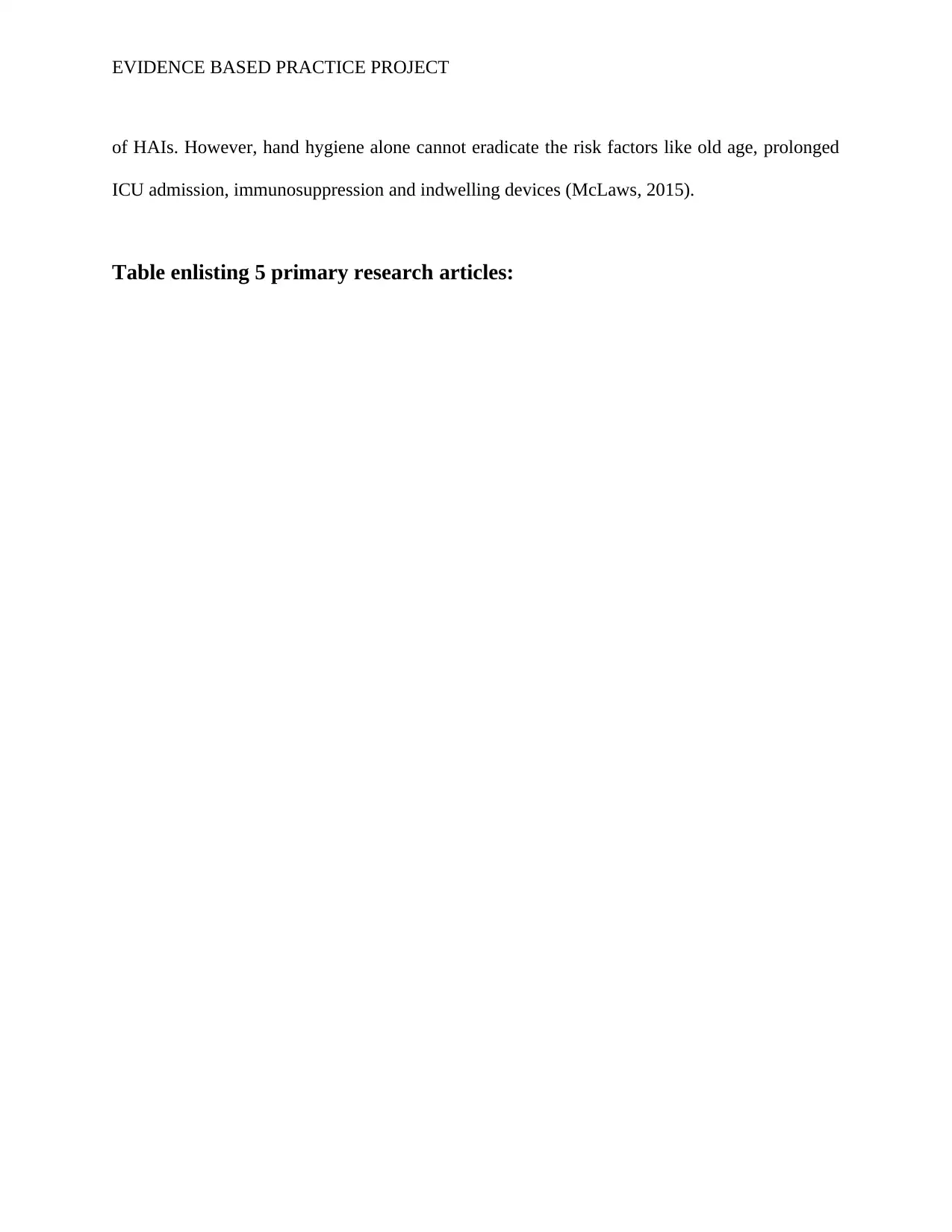
EVIDENCE BASED PRACTICE PROJECT
of HAIs. However, hand hygiene alone cannot eradicate the risk factors like old age, prolonged
ICU admission, immunosuppression and indwelling devices (McLaws, 2015).
Table enlisting 5 primary research articles:
of HAIs. However, hand hygiene alone cannot eradicate the risk factors like old age, prolonged
ICU admission, immunosuppression and indwelling devices (McLaws, 2015).
Table enlisting 5 primary research articles:
Paraphrase This Document
Need a fresh take? Get an instant paraphrase of this document with our AI Paraphraser
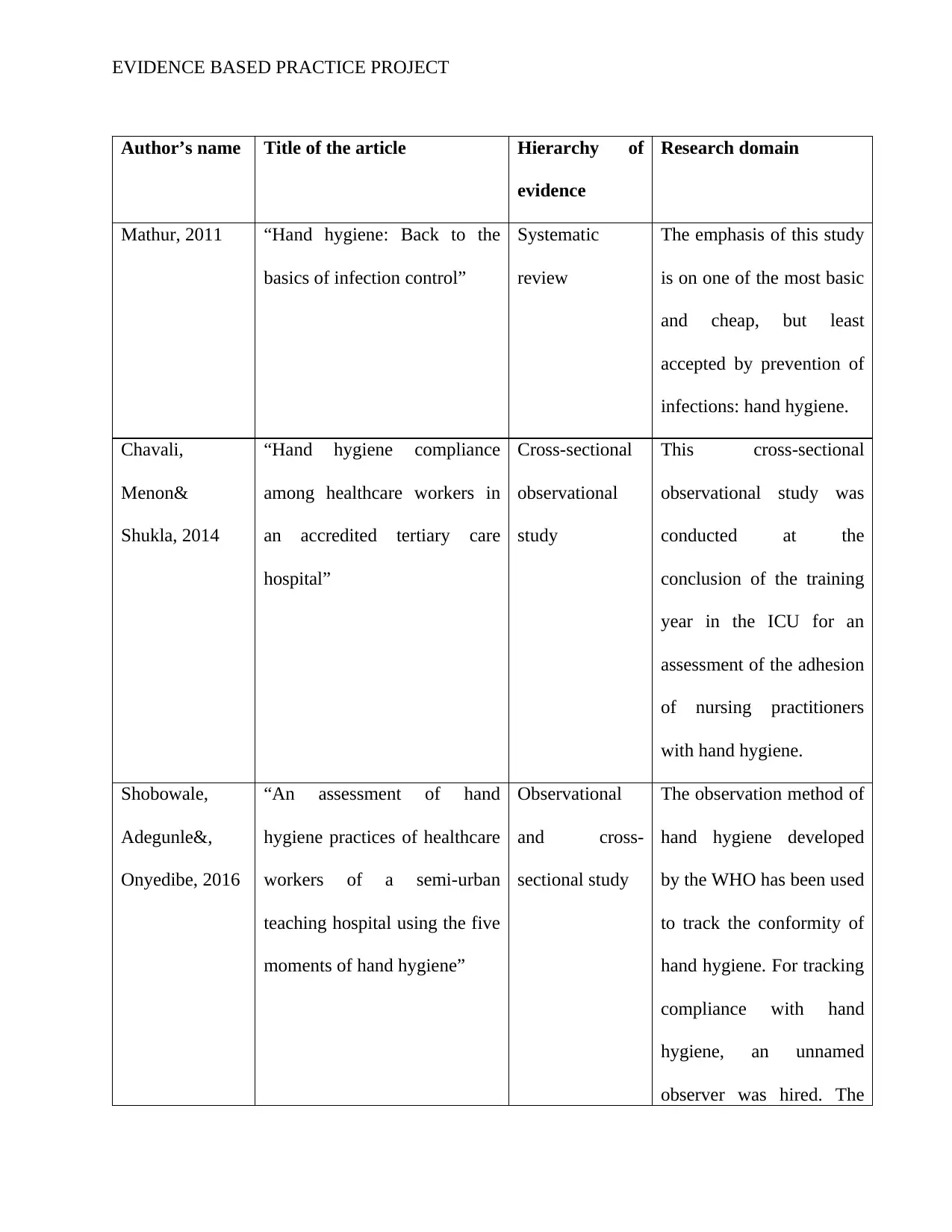
EVIDENCE BASED PRACTICE PROJECT
Author’s name Title of the article Hierarchy of
evidence
Research domain
Mathur, 2011 “Hand hygiene: Back to the
basics of infection control”
Systematic
review
The emphasis of this study
is on one of the most basic
and cheap, but least
accepted by prevention of
infections: hand hygiene.
Chavali,
Menon&
Shukla, 2014
“Hand hygiene compliance
among healthcare workers in
an accredited tertiary care
hospital”
Cross-sectional
observational
study
This cross-sectional
observational study was
conducted at the
conclusion of the training
year in the ICU for an
assessment of the adhesion
of nursing practitioners
with hand hygiene.
Shobowale,
Adegunle&,
Onyedibe, 2016
“An assessment of hand
hygiene practices of healthcare
workers of a semi-urban
teaching hospital using the five
moments of hand hygiene”
Observational
and cross-
sectional study
The observation method of
hand hygiene developed
by the WHO has been used
to track the conformity of
hand hygiene. For tracking
compliance with hand
hygiene, an unnamed
observer was hired. The
Author’s name Title of the article Hierarchy of
evidence
Research domain
Mathur, 2011 “Hand hygiene: Back to the
basics of infection control”
Systematic
review
The emphasis of this study
is on one of the most basic
and cheap, but least
accepted by prevention of
infections: hand hygiene.
Chavali,
Menon&
Shukla, 2014
“Hand hygiene compliance
among healthcare workers in
an accredited tertiary care
hospital”
Cross-sectional
observational
study
This cross-sectional
observational study was
conducted at the
conclusion of the training
year in the ICU for an
assessment of the adhesion
of nursing practitioners
with hand hygiene.
Shobowale,
Adegunle&,
Onyedibe, 2016
“An assessment of hand
hygiene practices of healthcare
workers of a semi-urban
teaching hospital using the five
moments of hand hygiene”
Observational
and cross-
sectional study
The observation method of
hand hygiene developed
by the WHO has been used
to track the conformity of
hand hygiene. For tracking
compliance with hand
hygiene, an unnamed
observer was hired. The
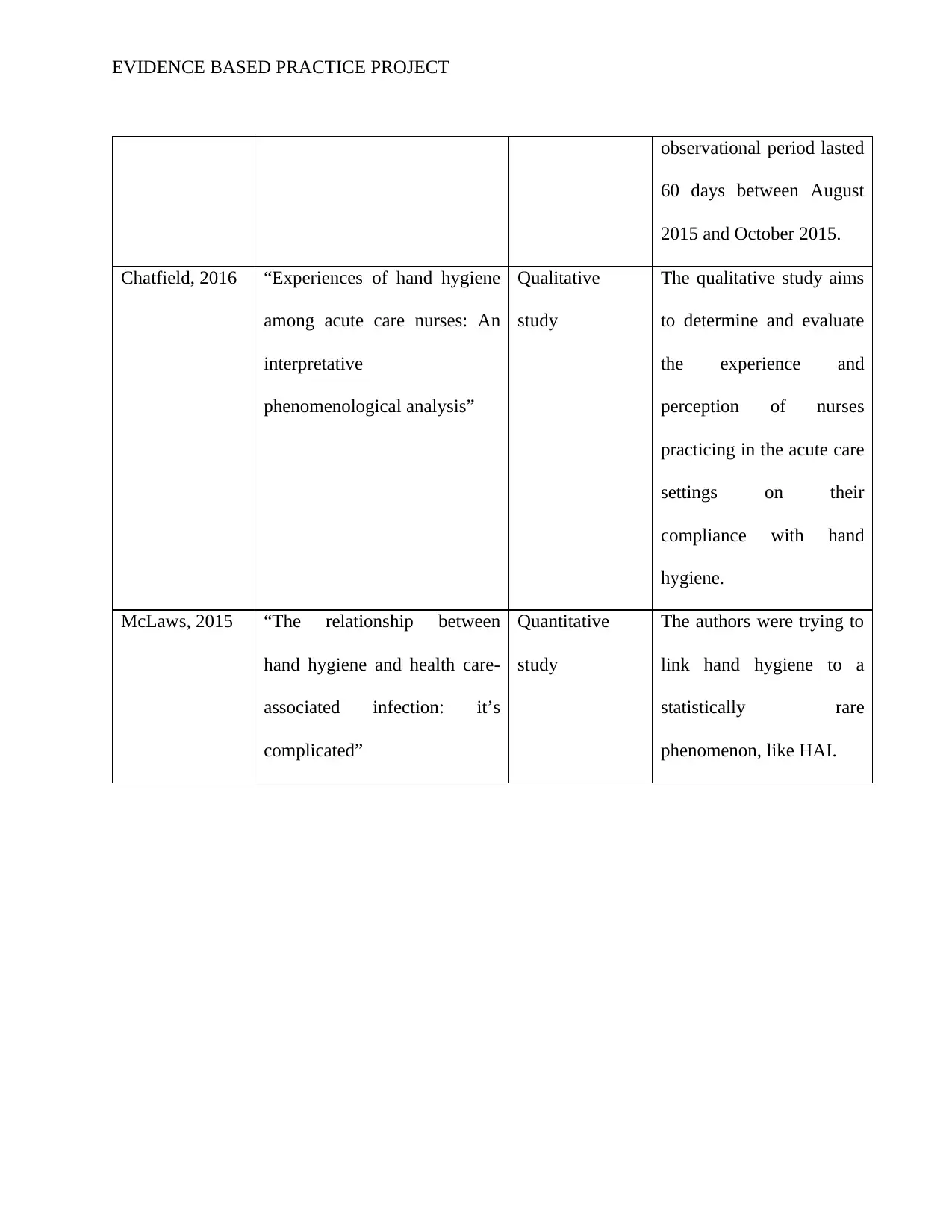
EVIDENCE BASED PRACTICE PROJECT
observational period lasted
60 days between August
2015 and October 2015.
Chatfield, 2016 “Experiences of hand hygiene
among acute care nurses: An
interpretative
phenomenological analysis”
Qualitative
study
The qualitative study aims
to determine and evaluate
the experience and
perception of nurses
practicing in the acute care
settings on their
compliance with hand
hygiene.
McLaws, 2015 “The relationship between
hand hygiene and health care-
associated infection: it’s
complicated”
Quantitative
study
The authors were trying to
link hand hygiene to a
statistically rare
phenomenon, like HAI.
observational period lasted
60 days between August
2015 and October 2015.
Chatfield, 2016 “Experiences of hand hygiene
among acute care nurses: An
interpretative
phenomenological analysis”
Qualitative
study
The qualitative study aims
to determine and evaluate
the experience and
perception of nurses
practicing in the acute care
settings on their
compliance with hand
hygiene.
McLaws, 2015 “The relationship between
hand hygiene and health care-
associated infection: it’s
complicated”
Quantitative
study
The authors were trying to
link hand hygiene to a
statistically rare
phenomenon, like HAI.
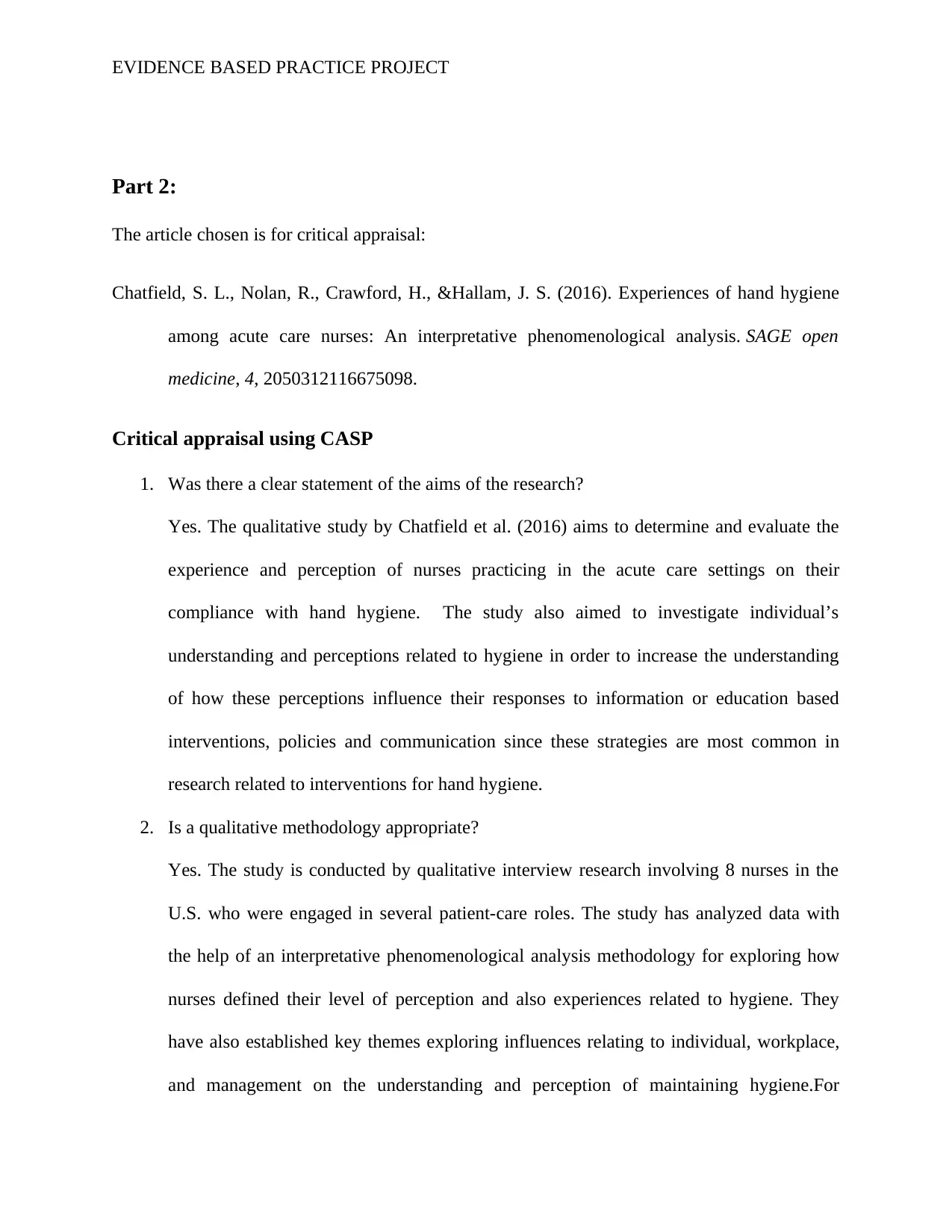
EVIDENCE BASED PRACTICE PROJECT
Part 2:
The article chosen is for critical appraisal:
Chatfield, S. L., Nolan, R., Crawford, H., &Hallam, J. S. (2016). Experiences of hand hygiene
among acute care nurses: An interpretative phenomenological analysis. SAGE open
medicine, 4, 2050312116675098.
Critical appraisal using CASP
1. Was there a clear statement of the aims of the research?
Yes. The qualitative study by Chatfield et al. (2016) aims to determine and evaluate the
experience and perception of nurses practicing in the acute care settings on their
compliance with hand hygiene. The study also aimed to investigate individual’s
understanding and perceptions related to hygiene in order to increase the understanding
of how these perceptions influence their responses to information or education based
interventions, policies and communication since these strategies are most common in
research related to interventions for hand hygiene.
2. Is a qualitative methodology appropriate?
Yes. The study is conducted by qualitative interview research involving 8 nurses in the
U.S. who were engaged in several patient-care roles. The study has analyzed data with
the help of an interpretative phenomenological analysis methodology for exploring how
nurses defined their level of perception and also experiences related to hygiene. They
have also established key themes exploring influences relating to individual, workplace,
and management on the understanding and perception of maintaining hygiene.For
Part 2:
The article chosen is for critical appraisal:
Chatfield, S. L., Nolan, R., Crawford, H., &Hallam, J. S. (2016). Experiences of hand hygiene
among acute care nurses: An interpretative phenomenological analysis. SAGE open
medicine, 4, 2050312116675098.
Critical appraisal using CASP
1. Was there a clear statement of the aims of the research?
Yes. The qualitative study by Chatfield et al. (2016) aims to determine and evaluate the
experience and perception of nurses practicing in the acute care settings on their
compliance with hand hygiene. The study also aimed to investigate individual’s
understanding and perceptions related to hygiene in order to increase the understanding
of how these perceptions influence their responses to information or education based
interventions, policies and communication since these strategies are most common in
research related to interventions for hand hygiene.
2. Is a qualitative methodology appropriate?
Yes. The study is conducted by qualitative interview research involving 8 nurses in the
U.S. who were engaged in several patient-care roles. The study has analyzed data with
the help of an interpretative phenomenological analysis methodology for exploring how
nurses defined their level of perception and also experiences related to hygiene. They
have also established key themes exploring influences relating to individual, workplace,
and management on the understanding and perception of maintaining hygiene.For
Secure Best Marks with AI Grader
Need help grading? Try our AI Grader for instant feedback on your assignments.
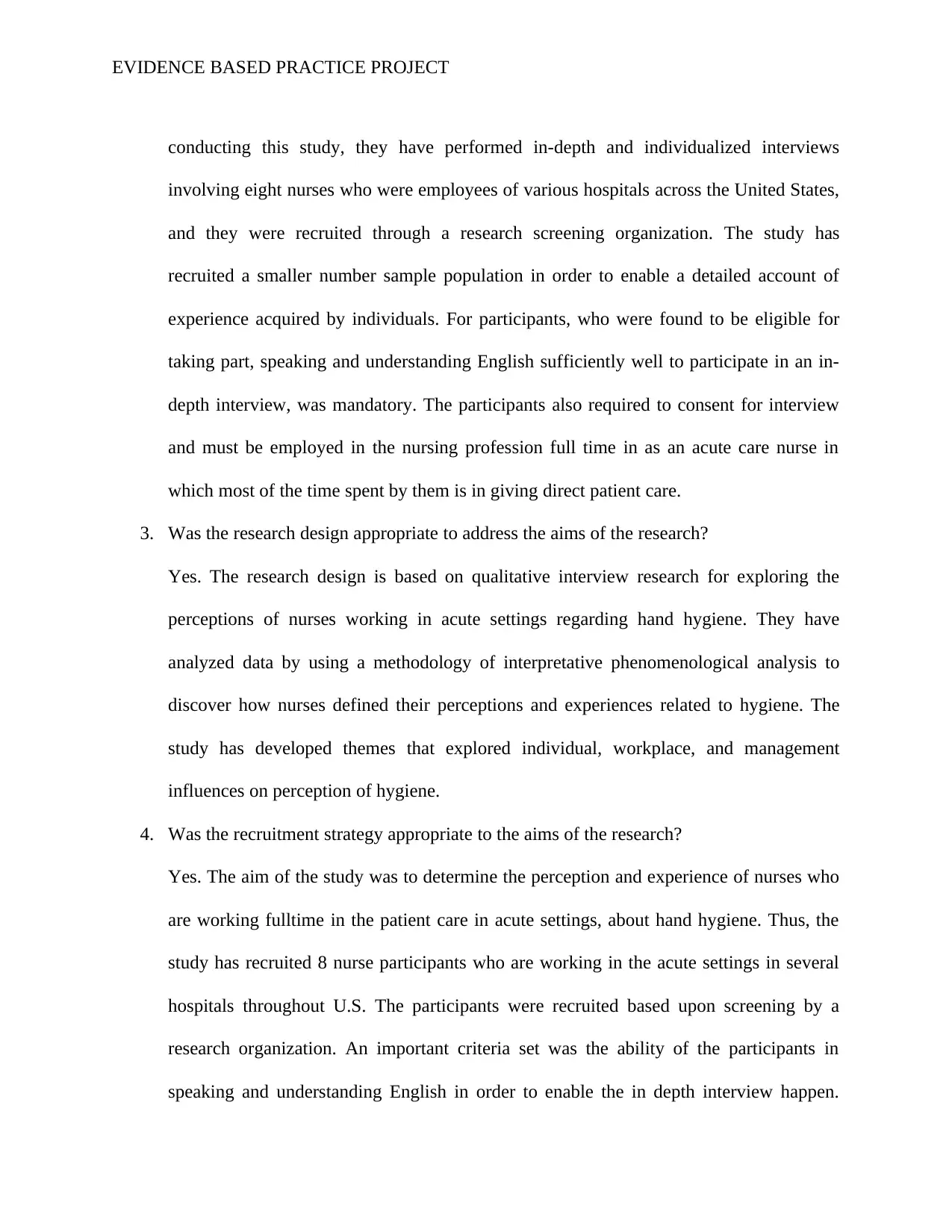
EVIDENCE BASED PRACTICE PROJECT
conducting this study, they have performed in-depth and individualized interviews
involving eight nurses who were employees of various hospitals across the United States,
and they were recruited through a research screening organization. The study has
recruited a smaller number sample population in order to enable a detailed account of
experience acquired by individuals. For participants, who were found to be eligible for
taking part, speaking and understanding English sufficiently well to participate in an in-
depth interview, was mandatory. The participants also required to consent for interview
and must be employed in the nursing profession full time in as an acute care nurse in
which most of the time spent by them is in giving direct patient care.
3. Was the research design appropriate to address the aims of the research?
Yes. The research design is based on qualitative interview research for exploring the
perceptions of nurses working in acute settings regarding hand hygiene. They have
analyzed data by using a methodology of interpretative phenomenological analysis to
discover how nurses defined their perceptions and experiences related to hygiene. The
study has developed themes that explored individual, workplace, and management
influences on perception of hygiene.
4. Was the recruitment strategy appropriate to the aims of the research?
Yes. The aim of the study was to determine the perception and experience of nurses who
are working fulltime in the patient care in acute settings, about hand hygiene. Thus, the
study has recruited 8 nurse participants who are working in the acute settings in several
hospitals throughout U.S. The participants were recruited based upon screening by a
research organization. An important criteria set was the ability of the participants in
speaking and understanding English in order to enable the in depth interview happen.
conducting this study, they have performed in-depth and individualized interviews
involving eight nurses who were employees of various hospitals across the United States,
and they were recruited through a research screening organization. The study has
recruited a smaller number sample population in order to enable a detailed account of
experience acquired by individuals. For participants, who were found to be eligible for
taking part, speaking and understanding English sufficiently well to participate in an in-
depth interview, was mandatory. The participants also required to consent for interview
and must be employed in the nursing profession full time in as an acute care nurse in
which most of the time spent by them is in giving direct patient care.
3. Was the research design appropriate to address the aims of the research?
Yes. The research design is based on qualitative interview research for exploring the
perceptions of nurses working in acute settings regarding hand hygiene. They have
analyzed data by using a methodology of interpretative phenomenological analysis to
discover how nurses defined their perceptions and experiences related to hygiene. The
study has developed themes that explored individual, workplace, and management
influences on perception of hygiene.
4. Was the recruitment strategy appropriate to the aims of the research?
Yes. The aim of the study was to determine the perception and experience of nurses who
are working fulltime in the patient care in acute settings, about hand hygiene. Thus, the
study has recruited 8 nurse participants who are working in the acute settings in several
hospitals throughout U.S. The participants were recruited based upon screening by a
research organization. An important criteria set was the ability of the participants in
speaking and understanding English in order to enable the in depth interview happen.
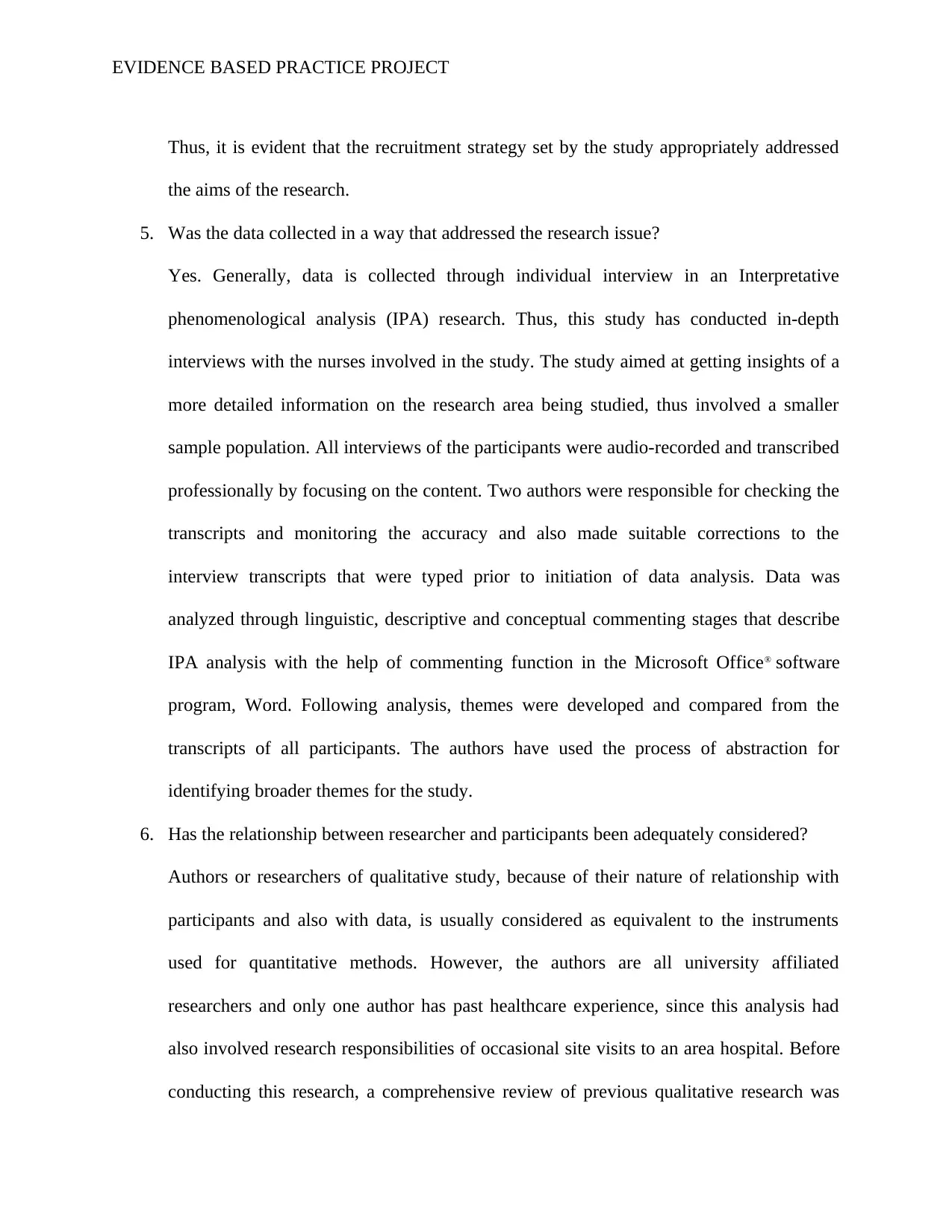
EVIDENCE BASED PRACTICE PROJECT
Thus, it is evident that the recruitment strategy set by the study appropriately addressed
the aims of the research.
5. Was the data collected in a way that addressed the research issue?
Yes. Generally, data is collected through individual interview in an Interpretative
phenomenological analysis (IPA) research. Thus, this study has conducted in-depth
interviews with the nurses involved in the study. The study aimed at getting insights of a
more detailed information on the research area being studied, thus involved a smaller
sample population. All interviews of the participants were audio-recorded and transcribed
professionally by focusing on the content. Two authors were responsible for checking the
transcripts and monitoring the accuracy and also made suitable corrections to the
interview transcripts that were typed prior to initiation of data analysis. Data was
analyzed through linguistic, descriptive and conceptual commenting stages that describe
IPA analysis with the help of commenting function in the Microsoft Office® software
program, Word. Following analysis, themes were developed and compared from the
transcripts of all participants. The authors have used the process of abstraction for
identifying broader themes for the study.
6. Has the relationship between researcher and participants been adequately considered?
Authors or researchers of qualitative study, because of their nature of relationship with
participants and also with data, is usually considered as equivalent to the instruments
used for quantitative methods. However, the authors are all university affiliated
researchers and only one author has past healthcare experience, since this analysis had
also involved research responsibilities of occasional site visits to an area hospital. Before
conducting this research, a comprehensive review of previous qualitative research was
Thus, it is evident that the recruitment strategy set by the study appropriately addressed
the aims of the research.
5. Was the data collected in a way that addressed the research issue?
Yes. Generally, data is collected through individual interview in an Interpretative
phenomenological analysis (IPA) research. Thus, this study has conducted in-depth
interviews with the nurses involved in the study. The study aimed at getting insights of a
more detailed information on the research area being studied, thus involved a smaller
sample population. All interviews of the participants were audio-recorded and transcribed
professionally by focusing on the content. Two authors were responsible for checking the
transcripts and monitoring the accuracy and also made suitable corrections to the
interview transcripts that were typed prior to initiation of data analysis. Data was
analyzed through linguistic, descriptive and conceptual commenting stages that describe
IPA analysis with the help of commenting function in the Microsoft Office® software
program, Word. Following analysis, themes were developed and compared from the
transcripts of all participants. The authors have used the process of abstraction for
identifying broader themes for the study.
6. Has the relationship between researcher and participants been adequately considered?
Authors or researchers of qualitative study, because of their nature of relationship with
participants and also with data, is usually considered as equivalent to the instruments
used for quantitative methods. However, the authors are all university affiliated
researchers and only one author has past healthcare experience, since this analysis had
also involved research responsibilities of occasional site visits to an area hospital. Before
conducting this research, a comprehensive review of previous qualitative research was
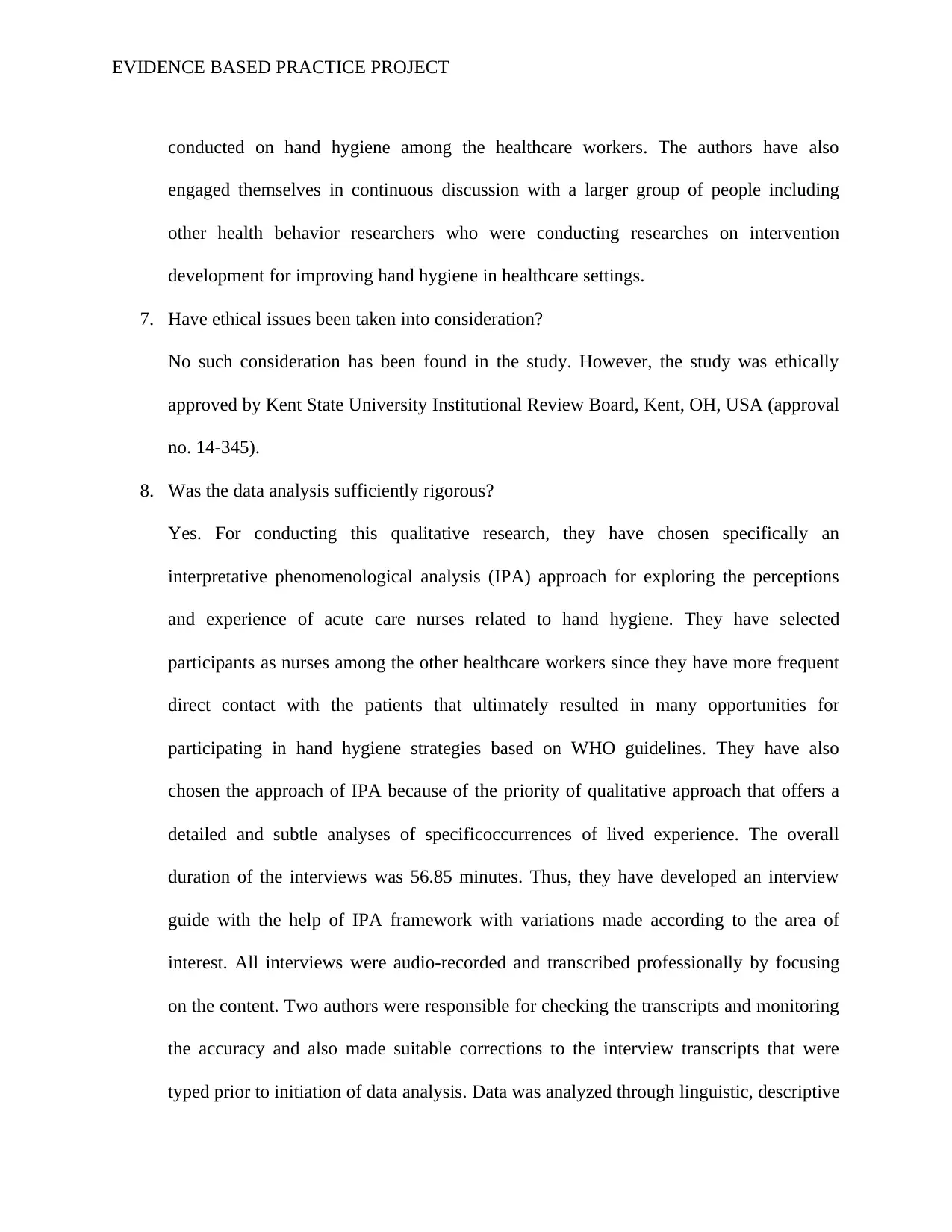
EVIDENCE BASED PRACTICE PROJECT
conducted on hand hygiene among the healthcare workers. The authors have also
engaged themselves in continuous discussion with a larger group of people including
other health behavior researchers who were conducting researches on intervention
development for improving hand hygiene in healthcare settings.
7. Have ethical issues been taken into consideration?
No such consideration has been found in the study. However, the study was ethically
approved by Kent State University Institutional Review Board, Kent, OH, USA (approval
no. 14-345).
8. Was the data analysis sufficiently rigorous?
Yes. For conducting this qualitative research, they have chosen specifically an
interpretative phenomenological analysis (IPA) approach for exploring the perceptions
and experience of acute care nurses related to hand hygiene. They have selected
participants as nurses among the other healthcare workers since they have more frequent
direct contact with the patients that ultimately resulted in many opportunities for
participating in hand hygiene strategies based on WHO guidelines. They have also
chosen the approach of IPA because of the priority of qualitative approach that offers a
detailed and subtle analyses of specificoccurrences of lived experience. The overall
duration of the interviews was 56.85 minutes. Thus, they have developed an interview
guide with the help of IPA framework with variations made according to the area of
interest. All interviews were audio-recorded and transcribed professionally by focusing
on the content. Two authors were responsible for checking the transcripts and monitoring
the accuracy and also made suitable corrections to the interview transcripts that were
typed prior to initiation of data analysis. Data was analyzed through linguistic, descriptive
conducted on hand hygiene among the healthcare workers. The authors have also
engaged themselves in continuous discussion with a larger group of people including
other health behavior researchers who were conducting researches on intervention
development for improving hand hygiene in healthcare settings.
7. Have ethical issues been taken into consideration?
No such consideration has been found in the study. However, the study was ethically
approved by Kent State University Institutional Review Board, Kent, OH, USA (approval
no. 14-345).
8. Was the data analysis sufficiently rigorous?
Yes. For conducting this qualitative research, they have chosen specifically an
interpretative phenomenological analysis (IPA) approach for exploring the perceptions
and experience of acute care nurses related to hand hygiene. They have selected
participants as nurses among the other healthcare workers since they have more frequent
direct contact with the patients that ultimately resulted in many opportunities for
participating in hand hygiene strategies based on WHO guidelines. They have also
chosen the approach of IPA because of the priority of qualitative approach that offers a
detailed and subtle analyses of specificoccurrences of lived experience. The overall
duration of the interviews was 56.85 minutes. Thus, they have developed an interview
guide with the help of IPA framework with variations made according to the area of
interest. All interviews were audio-recorded and transcribed professionally by focusing
on the content. Two authors were responsible for checking the transcripts and monitoring
the accuracy and also made suitable corrections to the interview transcripts that were
typed prior to initiation of data analysis. Data was analyzed through linguistic, descriptive
Paraphrase This Document
Need a fresh take? Get an instant paraphrase of this document with our AI Paraphraser
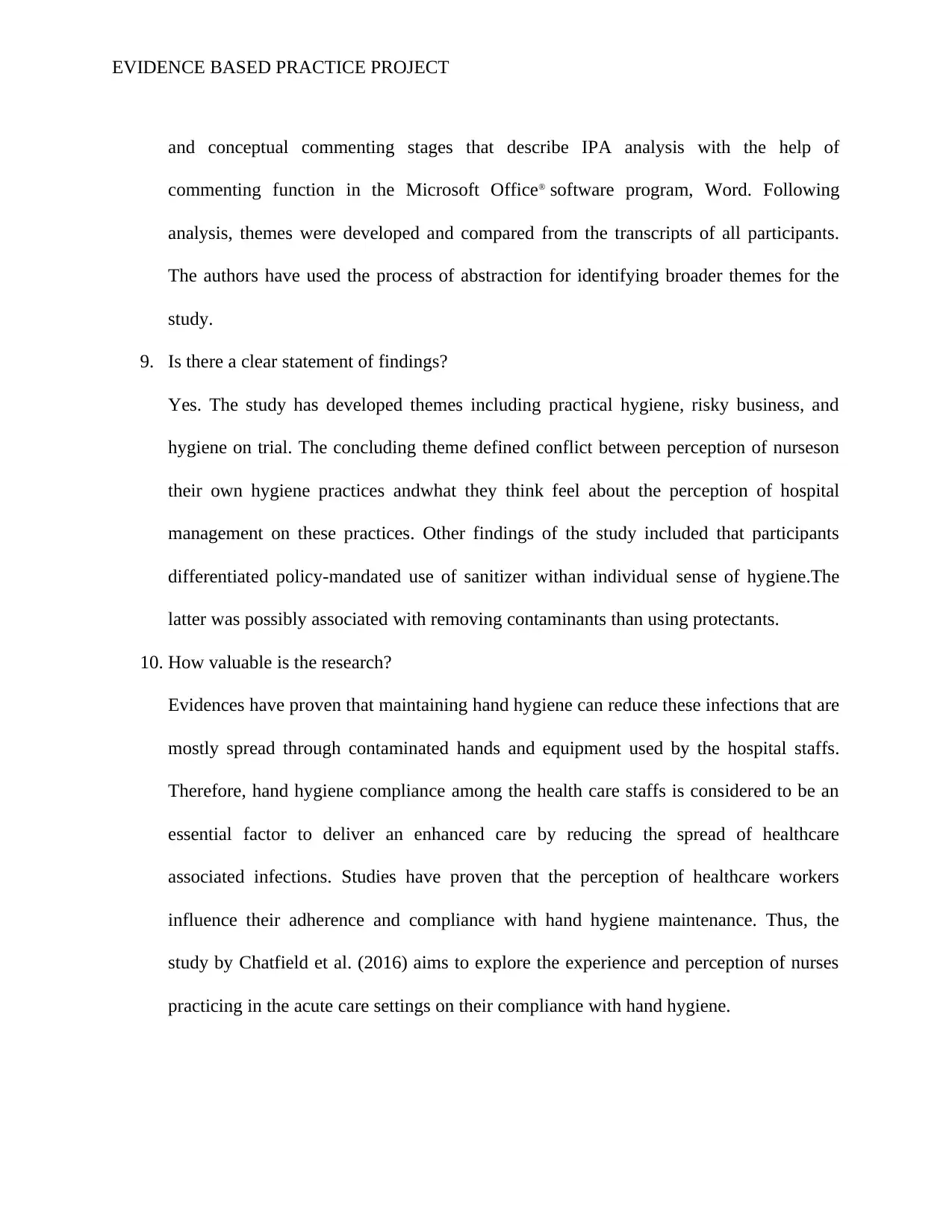
EVIDENCE BASED PRACTICE PROJECT
and conceptual commenting stages that describe IPA analysis with the help of
commenting function in the Microsoft Office® software program, Word. Following
analysis, themes were developed and compared from the transcripts of all participants.
The authors have used the process of abstraction for identifying broader themes for the
study.
9. Is there a clear statement of findings?
Yes. The study has developed themes including practical hygiene, risky business, and
hygiene on trial. The concluding theme defined conflict between perception of nurseson
their own hygiene practices andwhat they think feel about the perception of hospital
management on these practices. Other findings of the study included that participants
differentiated policy-mandated use of sanitizer withan individual sense of hygiene.The
latter was possibly associated with removing contaminants than using protectants.
10. How valuable is the research?
Evidences have proven that maintaining hand hygiene can reduce these infections that are
mostly spread through contaminated hands and equipment used by the hospital staffs.
Therefore, hand hygiene compliance among the health care staffs is considered to be an
essential factor to deliver an enhanced care by reducing the spread of healthcare
associated infections. Studies have proven that the perception of healthcare workers
influence their adherence and compliance with hand hygiene maintenance. Thus, the
study by Chatfield et al. (2016) aims to explore the experience and perception of nurses
practicing in the acute care settings on their compliance with hand hygiene.
and conceptual commenting stages that describe IPA analysis with the help of
commenting function in the Microsoft Office® software program, Word. Following
analysis, themes were developed and compared from the transcripts of all participants.
The authors have used the process of abstraction for identifying broader themes for the
study.
9. Is there a clear statement of findings?
Yes. The study has developed themes including practical hygiene, risky business, and
hygiene on trial. The concluding theme defined conflict between perception of nurseson
their own hygiene practices andwhat they think feel about the perception of hospital
management on these practices. Other findings of the study included that participants
differentiated policy-mandated use of sanitizer withan individual sense of hygiene.The
latter was possibly associated with removing contaminants than using protectants.
10. How valuable is the research?
Evidences have proven that maintaining hand hygiene can reduce these infections that are
mostly spread through contaminated hands and equipment used by the hospital staffs.
Therefore, hand hygiene compliance among the health care staffs is considered to be an
essential factor to deliver an enhanced care by reducing the spread of healthcare
associated infections. Studies have proven that the perception of healthcare workers
influence their adherence and compliance with hand hygiene maintenance. Thus, the
study by Chatfield et al. (2016) aims to explore the experience and perception of nurses
practicing in the acute care settings on their compliance with hand hygiene.
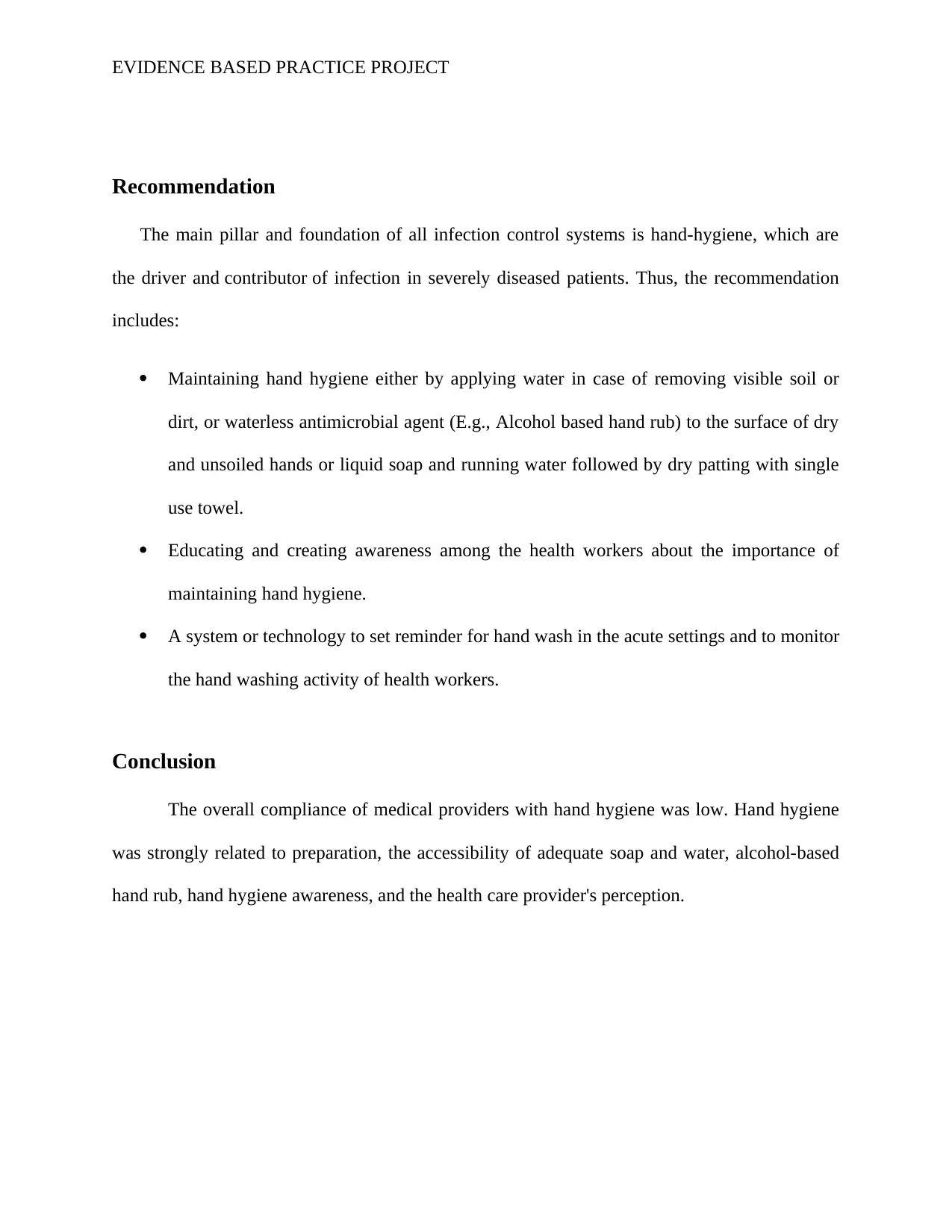
EVIDENCE BASED PRACTICE PROJECT
Recommendation
The main pillar and foundation of all infection control systems is hand-hygiene, which are
the driver and contributor of infection in severely diseased patients. Thus, the recommendation
includes:
Maintaining hand hygiene either by applying water in case of removing visible soil or
dirt, or waterless antimicrobial agent (E.g., Alcohol based hand rub) to the surface of dry
and unsoiled hands or liquid soap and running water followed by dry patting with single
use towel.
Educating and creating awareness among the health workers about the importance of
maintaining hand hygiene.
A system or technology to set reminder for hand wash in the acute settings and to monitor
the hand washing activity of health workers.
Conclusion
The overall compliance of medical providers with hand hygiene was low. Hand hygiene
was strongly related to preparation, the accessibility of adequate soap and water, alcohol-based
hand rub, hand hygiene awareness, and the health care provider's perception.
Recommendation
The main pillar and foundation of all infection control systems is hand-hygiene, which are
the driver and contributor of infection in severely diseased patients. Thus, the recommendation
includes:
Maintaining hand hygiene either by applying water in case of removing visible soil or
dirt, or waterless antimicrobial agent (E.g., Alcohol based hand rub) to the surface of dry
and unsoiled hands or liquid soap and running water followed by dry patting with single
use towel.
Educating and creating awareness among the health workers about the importance of
maintaining hand hygiene.
A system or technology to set reminder for hand wash in the acute settings and to monitor
the hand washing activity of health workers.
Conclusion
The overall compliance of medical providers with hand hygiene was low. Hand hygiene
was strongly related to preparation, the accessibility of adequate soap and water, alcohol-based
hand rub, hand hygiene awareness, and the health care provider's perception.
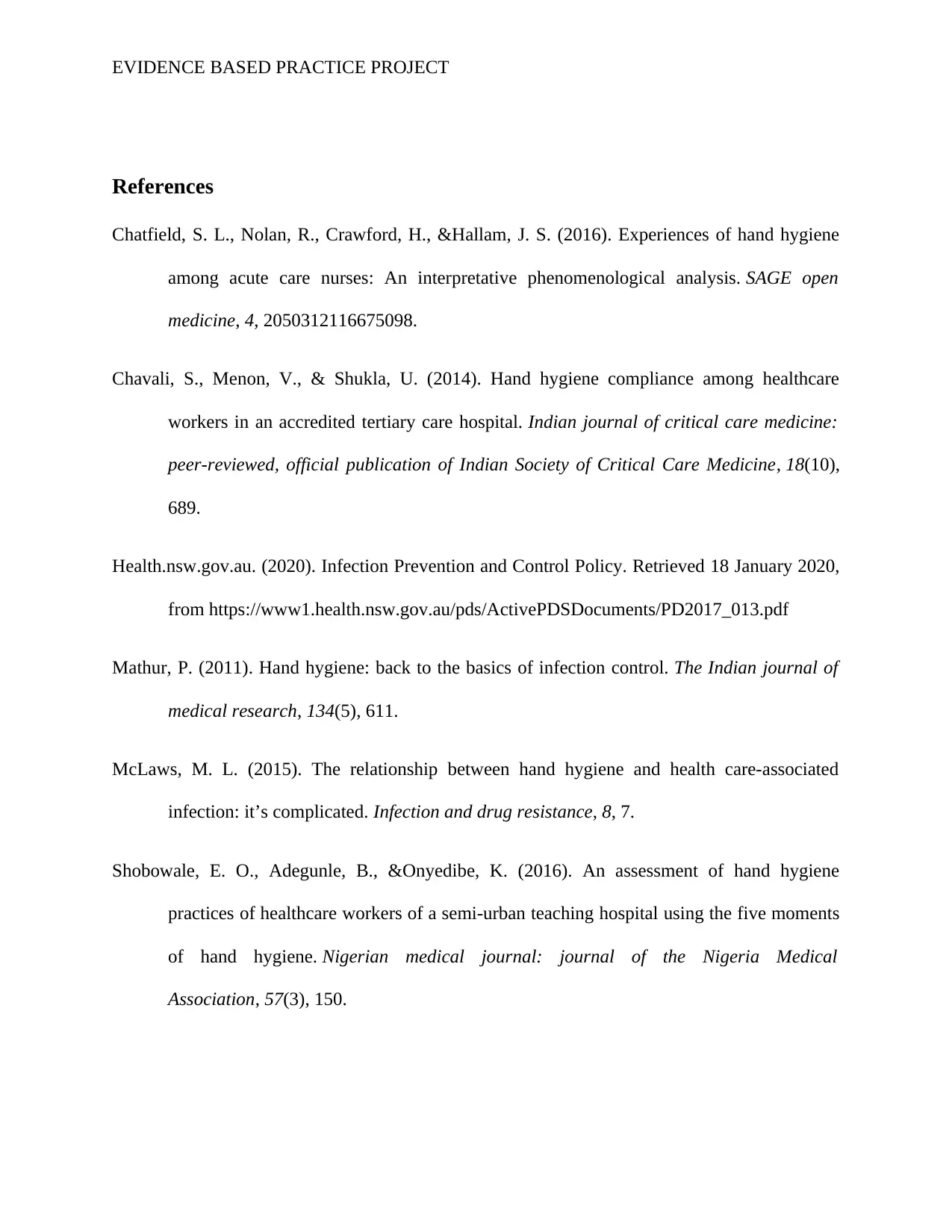
EVIDENCE BASED PRACTICE PROJECT
References
Chatfield, S. L., Nolan, R., Crawford, H., &Hallam, J. S. (2016). Experiences of hand hygiene
among acute care nurses: An interpretative phenomenological analysis. SAGE open
medicine, 4, 2050312116675098.
Chavali, S., Menon, V., & Shukla, U. (2014). Hand hygiene compliance among healthcare
workers in an accredited tertiary care hospital. Indian journal of critical care medicine:
peer-reviewed, official publication of Indian Society of Critical Care Medicine, 18(10),
689.
Health.nsw.gov.au. (2020). Infection Prevention and Control Policy. Retrieved 18 January 2020,
from https://www1.health.nsw.gov.au/pds/ActivePDSDocuments/PD2017_013.pdf
Mathur, P. (2011). Hand hygiene: back to the basics of infection control. The Indian journal of
medical research, 134(5), 611.
McLaws, M. L. (2015). The relationship between hand hygiene and health care-associated
infection: it’s complicated. Infection and drug resistance, 8, 7.
Shobowale, E. O., Adegunle, B., &Onyedibe, K. (2016). An assessment of hand hygiene
practices of healthcare workers of a semi-urban teaching hospital using the five moments
of hand hygiene. Nigerian medical journal: journal of the Nigeria Medical
Association, 57(3), 150.
References
Chatfield, S. L., Nolan, R., Crawford, H., &Hallam, J. S. (2016). Experiences of hand hygiene
among acute care nurses: An interpretative phenomenological analysis. SAGE open
medicine, 4, 2050312116675098.
Chavali, S., Menon, V., & Shukla, U. (2014). Hand hygiene compliance among healthcare
workers in an accredited tertiary care hospital. Indian journal of critical care medicine:
peer-reviewed, official publication of Indian Society of Critical Care Medicine, 18(10),
689.
Health.nsw.gov.au. (2020). Infection Prevention and Control Policy. Retrieved 18 January 2020,
from https://www1.health.nsw.gov.au/pds/ActivePDSDocuments/PD2017_013.pdf
Mathur, P. (2011). Hand hygiene: back to the basics of infection control. The Indian journal of
medical research, 134(5), 611.
McLaws, M. L. (2015). The relationship between hand hygiene and health care-associated
infection: it’s complicated. Infection and drug resistance, 8, 7.
Shobowale, E. O., Adegunle, B., &Onyedibe, K. (2016). An assessment of hand hygiene
practices of healthcare workers of a semi-urban teaching hospital using the five moments
of hand hygiene. Nigerian medical journal: journal of the Nigeria Medical
Association, 57(3), 150.
Secure Best Marks with AI Grader
Need help grading? Try our AI Grader for instant feedback on your assignments.

EVIDENCE BASED PRACTICE PROJECT
1 out of 17
Related Documents
Your All-in-One AI-Powered Toolkit for Academic Success.
+13062052269
info@desklib.com
Available 24*7 on WhatsApp / Email
![[object Object]](/_next/static/media/star-bottom.7253800d.svg)
Unlock your academic potential
© 2024 | Zucol Services PVT LTD | All rights reserved.





